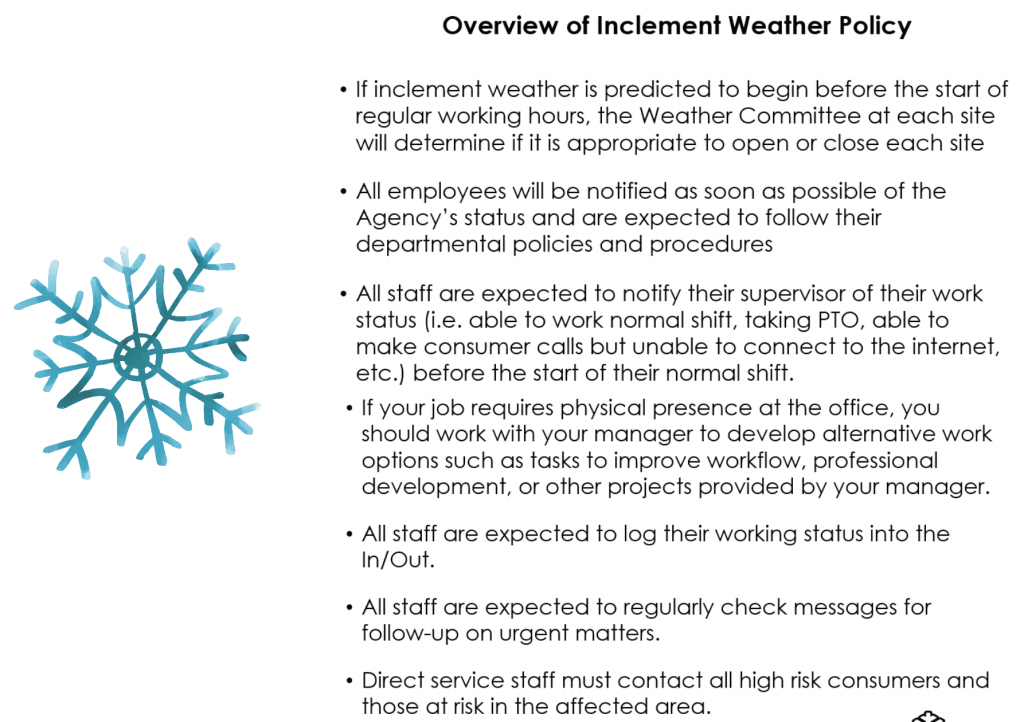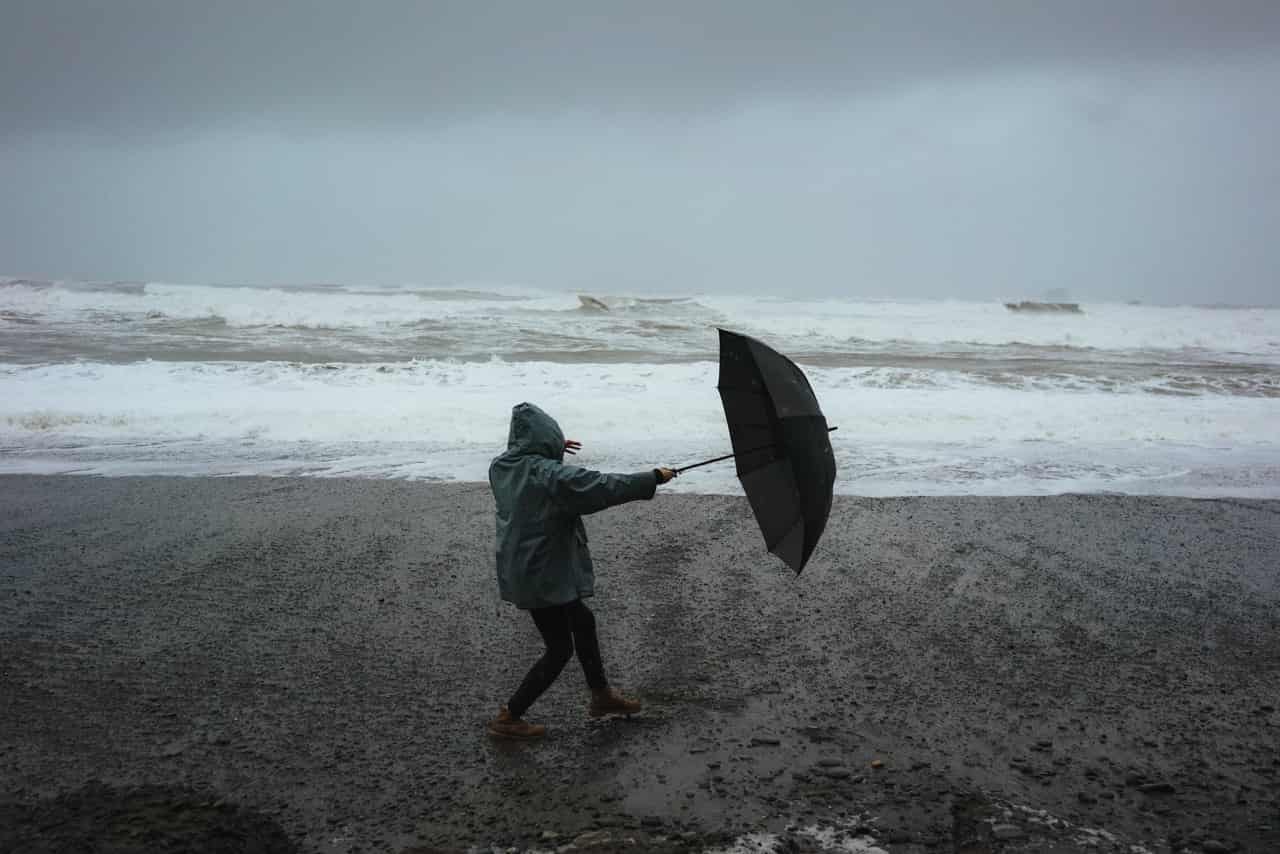Climate is what we expect and the weather is what we are forced to contend with. An organization cannot predict the future when it comes to the weather. But it can put its workforce in a better position when it has an efficient response plan in place.
We are surrounded by several uncontrollable and mercurial forces of nature. From hurricanes to floods, fierce weather can impact the working and productivity of employees.
What should the employees do when it is raining heavily outside?
Or what should remote staff do when they lose the internet connection or power?
How will you inform the employees about emergency office closure or reduced working hours?
In which weather conditions should outdoor employees seek shelter?
Although these can be one-off instances the result of poor planning can be catastrophic. On that account, every organization should have an integrated inclement weather policy. With an extensive policy in place, every employee should understand the impact of inclement weather on their safety and workloads.
Without further ado, let us dive into the details of an inclement weather policy and the steps to take to formulate a great one.
What is an Inclement Weather Policy?
How can one define inclement? Inclement is a term that is usually used to define harsh or severe weather. Extreme weather events can be detrimental to the operations and productivity of an organization. It can also cause a threat to the life of the employees who are working outdoors or maybe trying to travel to the office.
A well-crafted inclement weather policy can help in avoiding dangerous situations. It is a formal HR policy that explains what an employee is supposed to do in an extreme weather situation. In other words, an inclement weather policy for HR is a systematic way to notify workers about the possibility of office closure along with the steps they need to take.
The primary goal of every organization and its management is to keep everyone safe and sound. Management can refer to a previous severe weather policy sample for a better understanding of the subject. A great example of an inclement weather policy sample is the following one by ESMV.

Some common examples of inclement weather that an organization can encounter are:
- High winds
- Hurricanes
- Heavy rains
- Frigid Temperatures
- Snow and Sleet
- Wildfires
- Tornadoes
- Declaration of a State of Emergency
There are some other emergencies and unexpected events that aren’t quite weather-related but can also be considered emergency situations by some organizations. They are:
- Infectious Disease Outbreaks
- Major Power Outages
- Landslides
- Threats to Public Safety
- Wildfires
- Impassable Roads
- Transport Shut-Downs
How to Create an Inclement Weather Policy for your Organisation?
Understand the Weather Laws on the Federal and State Level
The definition of inclement weather varies for different organizations functioning in different states. For instance, states like Minnesota and California consider high temperatures as inclement weather. It can lead to rhabdomyolysis, kidney failure, and heatstroke.
If you are also about to draft an inclement weather policy for your organization, the first thing you need to do is to learn your weather laws. Managers should refer to the US Occupational Safety and Health Administration and the National Institute for Occupational Safety and Health to learn more about the workplace safety guidelines.
What is Inclement Weather According to the States Your Business Functions in
Once you’ve understood current weather laws, you need to understand what is inclement weather in your state. And how do you do that? By simply checking out local and federal weather policies.
Companies located in the USA should also get familiar with the FLSA provisions. It will help them in understanding how to deal with pay and work schedules when the business is provisionally shut down due to extreme weather. The management should also explore the guidelines of OSHA – Occupational Safety and Health Administration to minimize employee health risks due to harsh weather conditions.
Last but not least, organizations must pay special attention to all upcoming weather updates and their possible impact on employees.
Determine the Responsibilities of Employer and Employee
A good inclement weather policy is one that explicitly states who is responsible for what and when.
The intention of the management should always be to help employees in doing their jobs safely. The prime motive of creating this policy is to answer all questions that employees may have. It is the legal responsibility of an employer to provide safe working conditions to the employees. In other words, the management has to make sure that employees are never in any hazardous situation.
It should avoid forcing employees to report to work in risky weather conditions. One wrong move can damage the reputation of the organization and reduce employee engagement exponentially.
As far as employees are concerned, it is their responsibility to abide by the inclement weather policy of the organization. They must inform the employer in case they are unable to reach the office due to unpleasant weather conditions. If it is possible, they must continue to work from their homes and respond to official calls and emails.
Mention Critical and Non-Critical Employees
A popular postal service quote goes, “Neither rain nor snow nor gloom nor heat prevents these professionals from completing their duties.” The same goes for most organizations as well.
It is crucial to differentiate between critical and non-critical employees when it comes to drafting an inclement weather policy. However, it is not about the personnel specifically. It is more about their job roles. There are certain tasks that when withheld may impact the business.
In other words, some employees have to be on the toes to handle crucial job responsibilities even during extreme conditions. Customer support executives, payroll administrators, utility providers, and security staff are some common examples of inclement weather policy essential personnel.
Last but not least, make sure the employees are very well-aware about the category in which they fall. Managers should refer to the previous year’s severe weather policy sample for a better understanding of this clause.

Explain the Payment Policy for both Exempt vs Non-Exempt Employees
According to the FLSA, an organization is not legally bound to pay non-exempt and hourly employees for the hours they have not worked. They just need to pay for the hours worked. On the other hand, management is liable to pay the full compensation to the salaried and exempt employees, even if the business is closed. At times, to bridge this gap, organizations can draw on these PTO policies in the case of inclement weather.
Paid time off is a benefit given to the employees of an organization, wherein they get a certain number of hours as time off from work. The employees can use some time off as per their needs.
In the case of inclement weather where work is paused, employers can choose to count this as paid time off for employees.
Whatever route the management decides to take, they should explain exactly how and when both exempt and non-exempt workforce will be paid in case of inclement weather.
Liberal or Unscheduled Leave Policies
At times, the weather may not be severe enough to warrant the business closure. But the weather conditions might be hazardous enough to prevent an employee from reporting to work. Employees residing in outskirts or rural areas generally face this issue.
An effective adverse weather conditions policy should have a clarification on how work missed during such weather conditions will be handled. Liberal and unscheduled leave provisions should be covered under this subsection.
The management should also clarify if the missed working days will be counted as vacation days or will be paid under the company’s inclement weather policy.
Natural Calamities and Evacuations
The safety and security of employees are the priority of any organization worth it’s salt. There can be instances where natural calamities might trigger evacuations. Your inclement weather policy should always clarify what that entails. It should answer questions like:
- What is an employee supposed to do during emergency evacuation situations?
- How should they protect themselves and help colleagues?
- What are the processes for work handover and employee safety in emergency evacuations?
When deciding to go for business closure, organizations should take these factors into account.
Include All Possible Emergency Plans
Things can change drastically during inclement weather. Therefore, it is crucial to include emergency plans such as:
- What should an employee, customer, or client do when he is stuck in the office or store? Are there any emergency supplies available on the premises and where are they located?
- Where is the list of emergency contacts?
- Which mode of communication will the organization use to notify the employees and customers about inclement weather?
- Who will provide the details of office closures, reopening dates, and working schedules
- What are the emergency evacuation routes and where are they located?
- List the possible threats during, before, and after inclement weather?
- How will the organization resume or continue during an extended emergency? Who will be responsible to manage the departmental responsibilities?
Formulate Remote Work Policies
Can a particular work be performed remotely during emergencies? If yes, it should be listed in the inclement weather policy too.
Similarly, respective professionals should also be aware of this facility. It will help them in staying safe during dire weather conditions and will also not hamper their productivity. Details of the work timings, reporting manager, and other related responsibilities should also be mentioned in the policy.
Obviously, after the pandemic, almost all organizations have robust remote work policies that can help in crafting this clause of an inclement weather policy.

Design a Communication Plan
How will you inform the employees about the office closure? Should they wait for the manager’s call or simply follow the current inclement policy?
This is the last step but one of the most crucial in formulating an effective inclement weather policy. Instead of relying on tedious manual means like phone calls, organizations should opt for engagement and shift scheduling software.
These types of software will automatically notify the employees about any change in the work schedules and business operating hours. Managers can also use the company’s social media accounts to share closure news with customers.
As far as any emergency is concerned, make sure employees know how to contact their managers and teammates. Make sure that they also know how to contact emergency services if they are stuck in a bad situation.
Returning to Work
Suppose the cyclone has subsided or snowfall has stopped and things are getting back to normal. People are ready to come out of their homes to go to work. But wait. What are the rejoining instructions for your employees?
You see, an inclement weather policy is much more than declaring emergencies and closing the business. It is also one of the most crucial documents that define return to work regulations.
It is the final document that the employees will refer to once the weather is safe for commute and travel. Therefore, make sure you include a return to work clause in your inclement weather policy. Here are some essential points that you should not miss here:
- Is there a phase-wise plan for employees to return to work?
- How will the company inform its clients and customers about the reopening of business?
- Whom to contact for repairs or cleaning?
- Who will do inspect the site and declare that the office is now safe for all the employees
- After how many days of a major natural calamity should employees resume their job profiles?
A good inclement weather policy focuses on employee safety during all emergencies. Disciplining non-essential workforce for not coming to work can trigger major trust issues and conflicts in the organization.
Make sure you include all possible clauses in the inclement weather policy that can impact the productivity and working of the employees. In other words, organizations should try to make any inclement weather policy as comprehensive as they can for the best results.
Reach out to us at @HarmonizeHQ if you have any queries regarding your inclement weather policy.



